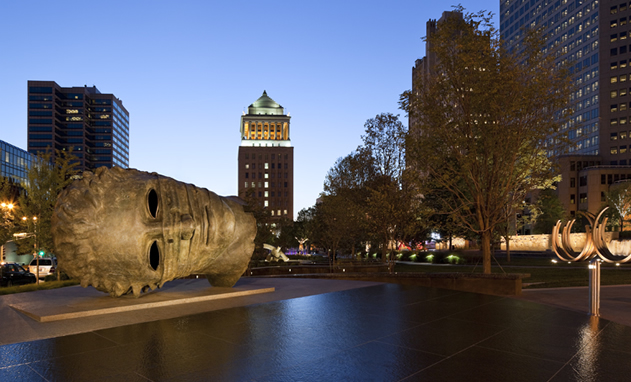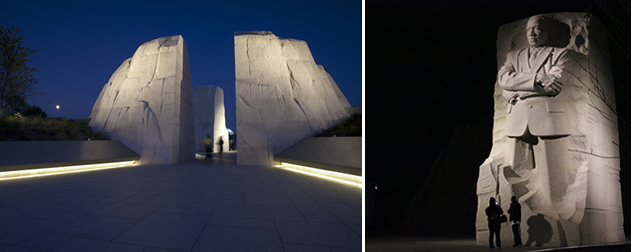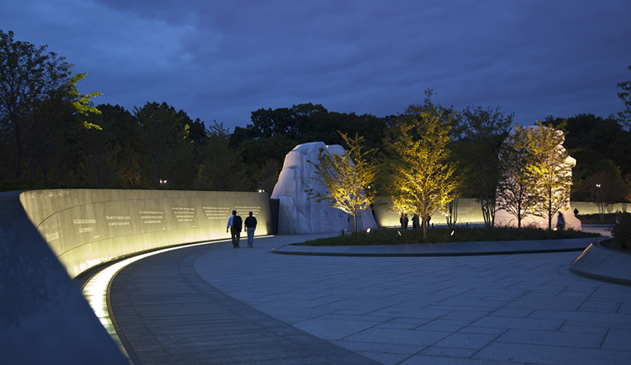The latest Philips Lumec blog entry by the company’s Sabrina-Santoro gives delves into the world of lighting designer Randy Burkett.
As a prominent figure in the lighting design industry, Randy Burkett, President and Design Principal at Randy Burkett Lighting Design, Inc. in St. Louis, MO, takes on roles in various associations as part of his goal to inspire future generations. He served a term (1996–1997) as President of the IALD and is currently the Chairman of the IALD Metrics of Quality Committee. In addition, Randy is a member of the IESNA Technical and Design Committees, and also on the advisory board for the annual CLUE Competition. Randy’s passion for his profession, and his extensive understanding of the art and science of light, is evident as he speaks about his countless experiences.
How would you characterize your firm’s lighting style?
The style of the firm is similar to my interests. We’ve molded a practice that really looks at both the art and science of light and have tailored our approach for specific projects and clients to meet their expectations and what they need from a lighting consultant, which is not always the same thing. We are very client-centric and try to fulfill their needs and expectations, but also know that we can bring in the other aspects of what we do when solving their problem.
It is difficult to make a clear distinction between the art and science of lighting, as the lines are nearly always blurred. A project that might be seen by a client or end user as beautiful and inspiring, is typically grounded in some level of technical rigor that goes unnoticed or unappreciated by the layperson. It’s almost like a bell curve, with the X-axis representing an intensity of importance between the pure art and science, and the Y-axis the number of projects exhibiting some mix of these constructs. Rarely do we see a lighting design so weighted in pure aesthetic or technical concerns so as to render the other unimportant. Ultimately, most projects exhibit some weighted balance between the two extremes.
 |
|
CityGarden, St-Louis, MO. (Photo Courtesy of Debbie Frankie) |
How important is sustainability to your customer base?
It’s becoming increasingly important and most clients that come to us have strong opinions about sustainability, which are often pushed from different directions. They’re interested and they want to do what’s right. They will even ask us if there’s anything we do as part of the sustainability efforts in our discipline, which they can tell others about when they see or use the space. When you see a LEED plaque in a building it now means something—it’s a perceived brand of excellence in design. It is becoming a much bigger part of what we do and we no longer need to intensely educate our clients in order for them to understand what it means to be sustainable in lighting.
What inspires you?
To this day I can say that I have passion for doing what I do. This discipline is so fascinating and influences all aspects of life—that’s the inspiring part! In some cases light influences environments in a very profound way. When you can recognize that then your client reaps the benefits of it and you feel good about what you’ve done. This is central inspiration for future projects as well.
What do you feel is the most important aspect of lighting design?
Overall as a professional lighting designer, the most important aspect is delivering a quality product to your client. That product changes from client to client and project to project, and you have to understand all the extraneous circumstances before you can provide a quality product. The end product result should not be the same every time you churn it out for a client, but you hope that the outcome is always a satisfied client and a successful project.
What about the CLUE competition? Can you expand on your role in this industry event and how you see it inspiring future generations?
This program has limitless possibilities. The CLUE Competition has already produced great work and had many successes at an international level. It can bring excitement to the future generation of emerging professionals. The biggest and most promising focus of the program is the creative energy that goes into producing responses for the competition and how those can be used to inspire others to create similar work and disseminate it to fellow professionals. The generations in their 20s and 30s right now are generally more global thinkers than previous generations because they’re instantly exposed to an entire world through phones, laptops, etc… so they collectively contribute to a different way of thinking.
“The most important aspect of competitions is what they can bring to our industry as a whole – recognition of the lighting profession as a discipline.”
CLUE should be brought to emerging professionals in a compelling way to generate enough interest so they will participate and meaningfully contribute. A competition like CLUE has potential for extremely positive results in the coming years as it could become a “go-to” kind of thing where people are interested and excited to find out what comes out of the competition. The most important aspect of competitions isn’t about giving out awards, but rather what they can bring to our industry as a whole— recognition of the lighting profession as a discipline and the importance of light as a design element.
As the program evolves, I see my role on the advisory board as trying to bring the knowledge I’ve gained in dealing with lighting as a design professional to assist in making continual improvements and innovations. The competition must grow in order to remain fresh and relevant.
What is your most memorable project?
I think my most memorable project is the lighting of the Jefferson National Expansion Memorial Arch in St. Louis—not only because I live and work in St. Louis, but mostly because of the lesser known things about the project. It was a design that had never been thought technically possible before, so in terms of surmounting a challenge it was probably one of the most important aspects of what we did. Later, it would open up some other incredible opportunities around the world for us. It was, at the time, the most intently we had ever dealt with the impact of lighting on the environment—indigenous water fowl, migrating birds, atmospheric light scatter—and how to balance those issues with the desire to light structures like the Arch in large scales urban environments. Being able to design projects that not only satisfy clients but serve society as a whole is important, which includes considering how light impacts other aspects of the environment.
 |
|
Jefferson National Expansion Memorial Gateway Arch, St Louis, MO.(Photo Courtesy of Debbie Frankie Photography) |
In lighting the St. Louis Arch we dealt with a lot of those issues, making the project particularly challenging, but also endlessly fascinating. Successfully completing this project gave me great satisfaction.
What was it like working on the Martin Luther King, Jr. Memorial? What were the most important things you had to consider to light this space?
First off, this project presented a wonderful opportunity to collaborate with an experienced colleague, David Mintz, which is something we don’t have the chance to do very often. What Martin Luther King, Jr. meant to the world is undeniable and it was an incredible honor to work on a project that celebrated him and his legacy. It was a challenging project from many standpoints—not only satisfying the vision of the MLK foundation, but also meeting the expectations of many other constituent groups.
 |
|
Martin Luther King Jr. Memorial (in collaboration with David A. Mintz),Washington, DC.
Photo (top left) by ©Anice Hoachlander, Hoachlander Davis Photography
Photo (top right) by Randy Burkett
|
We needed to consider a wide variety of often conflicting goals when approaching this project. We would be presenting the legacy of Dr. King to people who might only visit the monument once in their lifetime. We took that to heart and attempted to create an experience that was communicative with the hope that people would understand the significance of his contributions. If you visit the plaza during the day you get a sense of how really expansive the space is, as daylight pours into the plaza, emphasizing the sense of public place. As lighting designers, we began conceptually with the complete absence of light, layering on light as we saw appropriate to create the desired nighttime appeal—intimate, personal and often dramatic, yet safe and secure for the visitor. When you read the inscriptions on the wall and see the beautifully revealed sculpture of Dr. King from the darkened plaza below, it greatly heightens your experience. There’s a bit of theatrics in the lighting to create drama and emotions and I think this was vitally important to the project, along the technical requirements for lighting a large scale public place. We achieved much of what we wanted in creating an experience at night, making it memorable to those who choose to visit after dark.
 |
|
Martin Luther King Jr. Memorial (in collaboration with David A. Mintz) Washington, DC. (Photo by Ron Solomon Photography)
|
When you retire, what do you want people to remember you for?
Maybe if there’s one thing I can count on, it is that with the people I encounter in my work—clients, fellow professionals, colleagues, university students, or those in other design walks of life—we have an opportunity to talk or work together, I will have enriched their interest and passion for lighting design in some way. Passing on the excitement I feel working in this discipline is probably the best I can leave behind.















